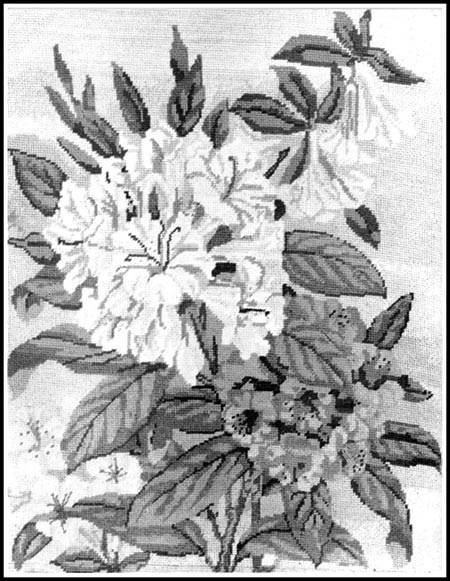QBARS - v11n4 Rhododendron Needlepoint
Rhododendron Needlepoint
By Mrs. Howard Plank, Islip, N.Y.

|
|
Fig. 41. Needlepoint showing top right R.
cinnabarinum
, 'Kewense',
arboreum
and lower left a Java hybrid 'Roseum'. Hagelstein photo |
As my husband's interest in growing rhododendrons grew, he suggested that when I was ripe to start a new piece of needlepoint I do one on rhododendrons. So I consulted the libraries of the New York Horticultural Society and of the New York Botanical Garden and spent many a pleasant moment turning over their prints and illustrations of the genus.
Finally I took a selection of material to Miss Mona Spoor who designs needlepoint, paints the canvas and works up a client's ideas with utmost sympathy and skill. We settled on a group of old prints and from this source she composed the arrangement of blossoms and leaves shown in the photograph. The colors of the leaves as well as those of the flowers truly reflect that particular charm of the rhododendron's variety and splendor, and were a pleasure to do. The background is an unobtrusive blend of soft pastels.
The variety at the upper right of the canvas and shown in the photograph is R. cinnabarinum , worked here in shades of yellow: the big central flower is R. 'Kewense', in white and pink with the prominent stamens visible; the lower right, R. arboreum in lovely tones of rose and dark red (my favorite of the group) and big effective leaves of a blue-green, a joy to work. At the lower left the only hybrids, from a group of varieties called in the old print, Java hybrids and of which the ones shown here (luteo roseum) are in a peach-apricot tone with shades of orange. The leaves in the center have a tone of olive-green, those at the top have yellow shades in them and these below are a mixture of gray green and darker tones.
It was a great and continuing joy to work this piece. At first my knowledge of rhododendrons was scant indeed and I found the going rather difficult. But oddly enough-in spite of the canvas being painted graphically--as I learned a little more about the lovely bush, working its replicas in this stylized way became easier and more delightful than ever.
We have mounted the finished canvas over a curved corner fireplace in our dining room. The walls are a fresco rose with the color in the plaster itself and the fireplace is faintly Spanish in conception. The tapestry, the flowers and the setting all seem to have become a modest spontaneous whole and we enjoy the fruits of our labors very much.
